If you’re looking for small tortoise species that won’t outgrow your home, you’re making a smarter decision than most new tortoise owners. In popular culture, tortoises are often portrayed as gentle giants—and species from the Galápagos Islands certainly live up to that reputation. But there are also several small tortoise species that never get bigger than a shoebox, and these compact tortoises make far better pets for most people.
Here’s why small tortoise species are particularly well-suited to pet ownership: they require dramatically less space than their giant cousins, don’t need outdoor enclosures that take up entire yards, and are manageable enough that one person can safely lift and move them for vet visits or enclosure cleaning. A sulcata tortoise might seem cute as a hatchling, but when it grows to 100+ pounds and needs 200 square feet of space, most owners realize too late they can’t provide appropriate care.
The problem is that many people adopt tortoises without understanding adult size requirements. They see a tiny baby at a pet store and don’t realize it will eventually need resources they can’t provide. By focusing on small tortoise species from the start, you’re setting yourself up for decades of successful tortoise keeping rather than a rehoming situation when your “small” tortoise outgrows every enclosure you own.
This guide will walk you through the best small tortoise species for pet owners, what makes each unique, their specific care requirements, and how to choose which compact tortoise species is right for your situation and experience level.
Understanding Small Tortoise Species Categories
To the untrained eye, one tortoise isn’t much different than the next. But among the 50 or so tortoise species currently living in the world, there’s tremendous diversity in size, care requirements, and suitability as pets. Most small tortoise species available to pet owners fall into two main groups.
Mediterranean Tortoises (Genus Testudo):
Nearly all pet tortoises smaller than 12 inches long belong to this Mediterranean group. Popular members include Russian, Egyptian, Greek, and Hermann’s tortoises, among several others. These small tortoise species are native to parts of eastern Europe, Asia, and North Africa.
Most Mediterranean tortoises live in shrublands that are arid but not quite desert-like. They’re exclusive herbivores spending most of their time grazing on grasses, low-growing shrubs, and occasional fruits or wildflowers. The fact that these small tortoise species live in relatively temperate climates makes them easier to care for than many other species. They fare quite well in average households when given appropriate enclosures, and can even live outdoors in some climates.
Their popularity in the pet trade also makes Mediterranean small tortoise species easier to acquire. In my experience, members of this group are least likely to be illegally sourced and are less expensive on average than rarer species. However, purchasing through reputable sources is still critically important to the wellbeing of wild tortoise populations.
Star Tortoises
This group includes several small tortoise species characterized by distinctive starburst patterns on their shells. The main pet trade members are the Indian star tortoise (Geochelone elegans) and Burmese star tortoise (Geochelone platynota). These species are native to parts of India, Pakistan, Sri Lanka, and Myanmar, primarily living in dry forests and shrublands.
Unfortunately, both species are at risk of extinction. Wild populations have been decimated by illegal pet trade driven by their unique appearance compared to more common species. Ethically bred star tortoises are expensive and difficult to obtain. If you’re considering these small tortoise species, verify your source is legitimate and that the tortoise was captive-bred, not wild-caught.
Why Choose Small Tortoise Species?
Many of the most popular pet tortoise species are also those that stay smallest. This isn’t coincidental—there are compelling practical reasons why small tortoise species make better pets for most keepers.
Space requirements stay manageable: Small tortoise species need far less space throughout their lives. While a sulcata requires 100-250 square feet as an adult, most small tortoise species thrive in 16-32 square feet. This means you can provide appropriate housing in spare bedrooms, dedicated indoor spaces, or modest outdoor enclosures rather than sacrificing entire yards.
Housing costs remain reasonable: Building and maintaining enclosures for small tortoise species costs a fraction of what giant species require. You won’t need industrial heating systems, massive quantities of substrate, or commercial-grade fencing. Many small tortoise species can be housed in custom-built indoor enclosures or converted furniture that fits into normal living spaces.
Handling and transport is realistic: Small tortoise species can be safely lifted and moved by one person for routine care, veterinary visits, or emergency situations. Try finding a veterinarian who can examine a 150-pound tortoise, then compare that to bringing a 2-pound tortoise in a simple carrier. The difference is dramatic.
Food costs stay modest: While all tortoises need appropriate diets, feeding small tortoise species costs far less than feeding giants that consume pounds of vegetation daily. The grocery bills and space needed to grow supplemental food plants remain reasonable for small tortoise species.
Long-term care is feasible: Small tortoise species are much more likely to receive appropriate care throughout their entire 50-100 year lifespans. They’re easier to rehome if necessary, more veterinarians can treat them, and they adapt better to life changes like moving to new homes or adjusting to different climates.
For growing small tortoise species, providing optimal nutrition without overfeeding is crucial. Our Baby Sulcata Superfood Powder works excellently for Mediterranean species as well, providing balanced nutrition specifically formulated for herbivorous small tortoise species during critical growth periods.
1. Egyptian Tortoise (Testudo kleinmanni)
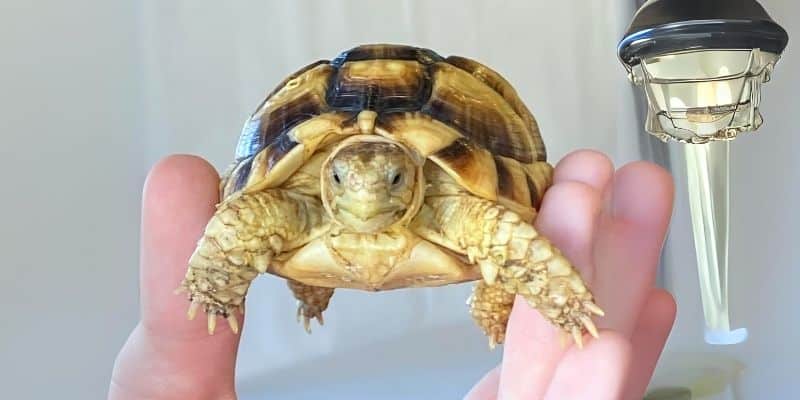
- Other Names: Kleinmann’s tortoise, Leith’s tortoise, Negev tortoise
- Conservation Status: Critically endangered
- Lifespan: 50 years or longer
- Adult Size: 5 inches, under 1 pound
The Egyptian tortoise is the smallest of not just Mediterranean small tortoise species but of any tortoise commonly seen in the pet trade. At maturity, this species measures just 5 inches long and weighs less than a pound on average. Some specimens are even smaller—males and particularly small females may be just 3 inches long.
Egyptian tortoises have noticeably domed shells and are literally “no bigger than a baked potato.” The typical specimen is light in color, reflecting its native habitat in Egyptian and Libyan deserts. Among small tortoise species, Egyptians are most well-adapted to hot, dry conditions compared to other Testudo species.
It’s common for these tiny tortoises to be most active during earliest and latest hours of the day. This behavior is a holdover from desert life where midday heat is dangerous. Egyptian tortoises also like to burrow or scuttle underneath larger rocks. Well-designed enclosures include spaces for easy hiding and sheltering from bright lights.
Many owners provide daily mist or fog to Egyptian tortoise enclosures. With this setup, it’s extremely important that enclosures completely dry out each day. Egyptian tortoises aren’t built to handle prolonged humidity over 60%. This makes them slightly more demanding than other small tortoise species from more temperate regions.
2. Russian Tortoise (Testudo horsfieldii)
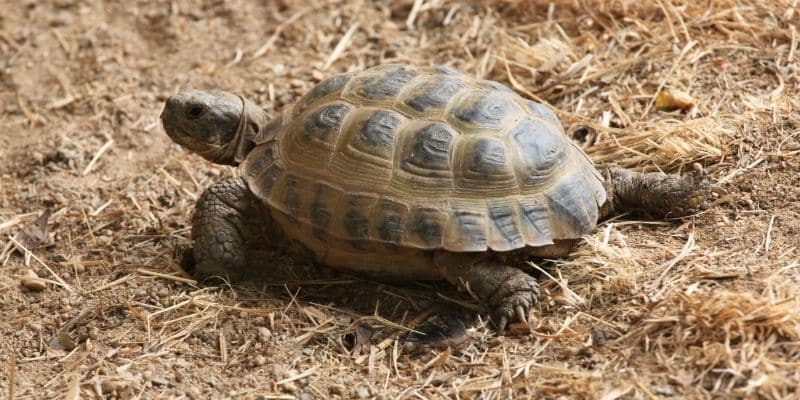
- Other Names: Afghanistan tortoise, steppe tortoise, Horsfield’s tortoise, four-toed tortoise
- Conservation Status: Vulnerable
- Lifespan: Up to 50 years
- Adult Size: 8 inches, 2-3 pounds
The Russian tortoise is one of the most common small tortoise species kept as pets. It’s relatively easy to care for and remains small enough to keep indoors in appropriate enclosures. I often see Russian tortoises recommended to new owners, and for good reason—they’re hardy, adaptable, and personable.
Mature Russian tortoises grow up to 8 inches long and weigh around 2-3 pounds maximum. Female tortoises are bigger on average and also have rounder shells than male counterparts. This size makes them ideal small tortoise species for apartment living or homes with limited space.
These tortoises have a fairly large native range. Unsurprisingly, many Russian tortoises are found in Russia, but there are also noteworthy populations in China and throughout the Middle East. This species is found further east than any other within the Testudo genus, making them exceptionally cold-hardy among small tortoise species.
Russian tortoise habitats include dry hills and steppes predominantly covered in rocks and sand. Like other Mediterranean small tortoise species, the bulk of their diet comes from tough grasses and shrubs. While not true desert tortoises, they’re adapted to survive long periods with little to no water.
Wild Russian tortoises typically hibernate for up to 5 months yearly. While captive hibernation is often recommended for health benefits, note that pet tortoises don’t always want or need to hibernate. Work with a reptile veterinarian to determine if hibernation is appropriate for your individual tortoise.
Are You Starving Your Tortoise?
Save 10% on premium tortoise food and supplements from Tortoise Resource Center on Amazon now using code BUYNOWGET10
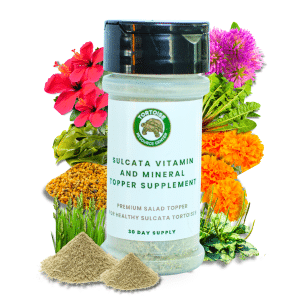
Sulcata Vitamin & Mineral Topper Supplement
30-Day Supply | 2 oz (56 g)
$24.99
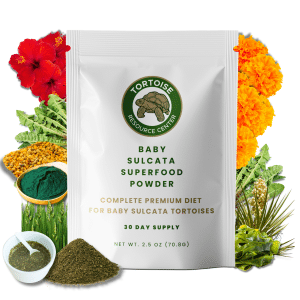
Baby Sulcata Tortoise Superfood Powder
30-Day Supply | 2.5 oz (70.8 g) Bag
$24.99
3. Greek Tortoise (Testudo graeca)
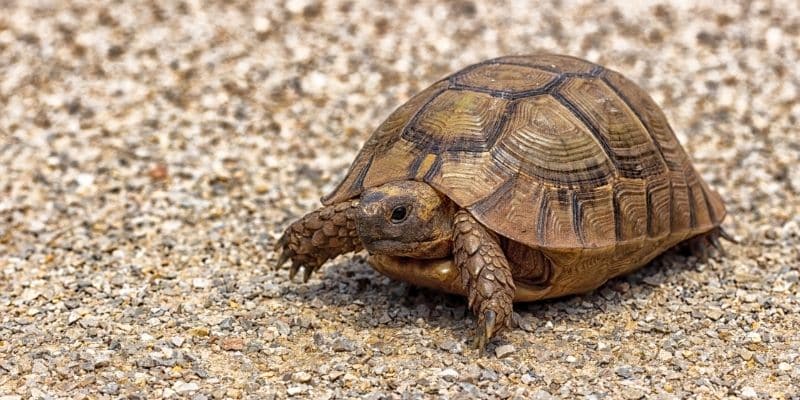
- Other Names: Moorish tortoise, spur-thighed tortoise
- Conservation Status: Vulnerable
- Lifespan: Up to 100 years or longer
- Adult Size: 6-10 inches, 2-4 pounds
The Greek tortoise is another popular small tortoise species often kept as pets, known for attractive appearance and relatively easy care requirements. Like Russian tortoises, Greeks are small enough for indoor housing with appropriate setups, making them great choices for all climates.
Adult Greek tortoises typically reach lengths of 6-10 inches, with females slightly larger than males. They have domed, yellow or tan-colored shells marked with dark blotches. Several subspecies of Greek tortoise are recognized in the pet trade—including Ibera and golden Greek tortoises—which have more distinct colorings, though all remain among the best small tortoise species for pets.
Native to Europe, Asia, and parts of North Africa, Greek tortoises inhabit ranges of environments from dry scrublands to salty coastal areas. Like other Mediterranean small tortoise species, their diet consists mainly of fibrous plants such as grasses and rough leafy greens.
Greek tortoises are known for particularly lengthy life expectancies among small tortoise species. The average captive tortoise lives to 75 or older, with some Greek tortoises documented living to 125 years. This extreme longevity means your Greek tortoise may outlive you, requiring estate planning consideration.
4. Hermann’s Tortoise (Testudo hermanni)
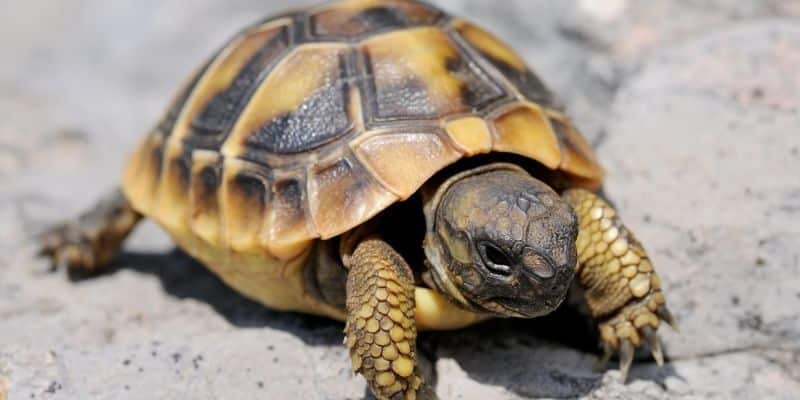
- Other Names: Dalmatian tortoise
- Conservation Status: Near threatened
- Lifespan: 50 to 100 years
- Adult Size: 6-8 inches, 1.5-4 pounds
While lesser-known than some Mediterranean small tortoise species, Hermann’s tortoises are quickly gaining popularity among enthusiasts. Their moderate size, attractive patterns, and engaging personalities make them excellent pets for dedicated keepers.
Fully grown Hermann’s tortoises usually reach 6-8 inches in length, with females generally larger than males. Their shells are yellow with brown or black markings, though exact colors and patterns vary individually. This variation makes each Hermann’s unique among small tortoise species.
Hermann’s tortoises are native to southern Europe, primarily found across Italy, Spain, and the Balkans. They thrive in average Mediterranean climates, living in rocky hillsides, scrublands, and forests. There are two subspecies—Western and Eastern Hermann’s—with Western subspecies staying smaller.
Many Hermann’s owners remark that these small tortoise species have particularly calm, laid-back personalities. A Hermann’s tortoise may grow attached to its owner with consistent care and attention, showing recognition and even seeking interaction during feeding times.
With that said, Hermann’s tortoises aren’t ideal house pets despite small size. This species much prefers outdoor enclosures in climates mimicking the Mediterranean. They can be kept indoors but thrive best with outdoor access during appropriate weather.
5. Indian Star Tortoise (Geochelone elegans)
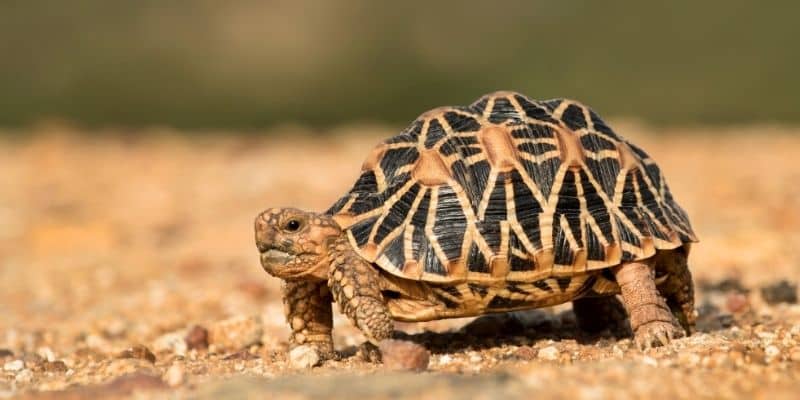
- Other Names: Star tortoise
- Conservation Status: Vulnerable
- Lifespan: Up to 80 years
- Adult Size: Males 6-7 inches, Females 10 inches
Despite relative rarity in the pet trade, the Indian star tortoise is well-known for its striking shell appearance among small tortoise species. Mature Indian stars are moderately sized, with females measuring about 10 inches long and males just 6-7 inches long. The dramatic size difference between sexes is unusual among small tortoise species.
Indian star tortoises are unique in that they’re native to dry parts of south Asia but can also survive the area’s seasonal monsoons. This tortoise is one of the trickier small tortoise species to keep because its natural habitat is so difficult to replicate. They need specific temperature and humidity combinations that challenge many keepers.
Most pet Indian star tortoises are kept in outdoor enclosures. This requires living in areas with the right combination of heat and humidity to meet their needs. While keeping these small tortoise species indoors is rare, it’s possible with closed enclosures making it easier to control ambient humidity.
Adult Indian star tortoises require humidity levels between 40-75%. Enclosure temperature should be at or above room temperature with isolated basking spots at 95-100°F. Maintaining these parameters makes them more demanding than other small tortoise species covered here.
While caring for Indian stars can be very rewarding, they’re also known for being exceptionally shy among small tortoise species. Your pet will not enjoy handling and will likely prefer spending most time being left alone. This makes them better display animals than interactive pets.
6. Pancake Tortoise (Malacochersus tornieri)
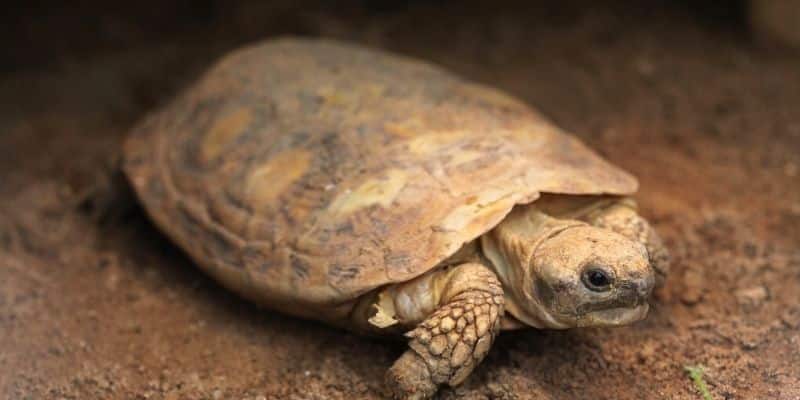
- Other Names: Tornier’s tortoise
- Conservation Status: Critically endangered
- Lifespan: 35 years or longer
- Adult Size: 5-7 inches, under 1 pound
Even less common than Indian star tortoises, the pancake tortoise is one of the most unique small tortoise species available. This species is incredibly distinctive thanks to its flat, flexible shell—a complete departure from typical domed tortoise shells. Don’t let that fool you though, because pancake tortoises are also surprisingly agile among small tortoise species. Adults measure just 5-7 inches long.
Pancake tortoises come from East Africa. Their natural habitats consist almost entirely of rocky hillsides. This species is well-equipped to scramble over and hide among rocks, which is why pancake tortoises evolved such interesting shapes. The flat profile allows them to wedge into narrow rock crevices where predators can’t follow.
While pet tortoises hopefully have no reason to actually hide from danger, this species still enjoys sliding into crevices between rocks and other structures. Enclosures should accommodate this, providing environments that allow pancake tortoises to engage in natural survival instincts. Without appropriate hiding spots, these small tortoise species become stressed and don’t thrive.
Pancake tortoises come from deserts but still require relatively high humidity compared to other small tortoise species. Remember that these tortoises spend most time in burrows and rock crevices, which can be much more humid than outside air. Aim for daytime humidity levels of 50-60%.
Like other small tortoise species in this article, pancake tortoises are herbivores. Their diet consists almost entirely of grasses and leafy greens. Ensuring proper mineral balance for these rare small tortoise species is essential. Our Vitamin and Mineral Topper provides comprehensive mineral support specifically formulated for herbivorous tortoises, helping ensure complete nutrition even when fresh food variety is limited.
Choosing the Right Small Tortoise Species
Selecting a pet tortoise isn’t about which small tortoise species looks or sounds coolest. This is a potentially lifelong commitment requiring careful consideration of both your needs and the tortoise’s needs for decades to come.
I always advise researching what current owners say about any small tortoise species you’re considering. This is a great way to learn about nitty-gritty details that go into caring for both common and niche species on this list. Web forums and social media platforms like Reddit provide invaluable real-world insights from experienced keepers of various small tortoise species.
Once you’ve narrowed down a few possible small tortoise species, housing should be your biggest consideration. Each species has unique housing needs you may or may not be able to accommodate. Do you live in a climate permitting year-round outdoor enclosures? If not, look at small tortoise species that thrive indoors—primarily members of the Mediterranean group.
Remember that even the smallest tortoise species need substantial space to remain happy and healthy. Don’t assume “small” means “can live in a tiny tank.” A Russian tortoise staying 8 inches long still needs minimum 16 square feet of floor space. If you’re tight on space, a two-story enclosure may be an option for some small tortoise species.
Temperature and humidity requirements: Different small tortoise species have dramatically different environmental needs. Egyptian tortoises need hot, dry conditions while Indian stars require higher humidity with seasonal variations. Russian tortoises are cold-hardy and can handle temperature fluctuations, while pancake tortoises need consistent warmth. Match species requirements to what you can reliably provide.
Availability and ethics: Some small tortoise species are readily available from reputable breeders, while others are rare and often illegally sourced. Stick with commonly bred small tortoise species like Russians, Greeks, and Hermann’s unless you’re experienced enough to verify ethical sourcing for rarer species. Never purchase wild-caught tortoises—this decimates wild populations.
Experience level: Mediterranean small tortoise species (Russian, Greek, Hermann’s, Egyptian) are generally more forgiving for beginners. Star tortoises and pancake tortoises require more precise environmental control and are better suited to experienced keepers. Start with easier small tortoise species and work up to more challenging species once you’ve mastered basic tortoise care.
Long-Term Considerations for Small Tortoise Species
Even small tortoise species live extraordinarily long lives. The tiny Egyptian tortoise lives 50 years on average, with some reaching 75-100 years with proper care. Greek tortoises regularly live past 100 years. These aren’t pets you’ll outgrow—they may outlive you.
Estate planning: Seriously consider what happens to your tortoise if you pass away before they do. Many small tortoise species will outlive their original owners. Who will care for your tortoise? Do you have legal arrangements in place ensuring they receive appropriate care?
Financial commitment: Calculate lifetime costs for small tortoise species. Even modest ongoing expenses add up over 50-100 years. Veterinary care, appropriate housing, quality food, and supplements cost money for decades. Can you sustain these costs through retirement and potential financial changes?
Lifestyle changes: Your life will change dramatically over a tortoise’s lifespan. Will your small tortoise species adapt to moves, climate changes, or household changes? Plan for flexibility or choose robust species like Russians that handle change better than sensitive species like Indian stars.
Ready to Choose Your Perfect Small Tortoise Species?
Understanding small tortoise species options is the first step toward decades of successful tortoise keeping. By choosing appropriately sized species from the start, you’re setting yourself up for realistic, sustainable care rather than the rehoming situations that plague giant tortoise ownership.
The small tortoise species covered here offer tremendous variety in appearance, personality, and care requirements while all staying manageable sizes for typical households. From the tiny Egyptian tortoise perfect for compact spaces to the slightly larger Greek tortoise known for century-long lifespans, there’s a small tortoise species appropriate for nearly every dedicated keeper.
Want comprehensive guidance on choosing and caring for the perfect small tortoise species for your situation? Sign up for our free bonus pack and get instant access to species comparison guides, housing requirement calculators, care sheets for all popular small tortoise species, and decision trees helping you select the best match for your experience level and resources. Plus you’ll receive feeding schedules, health monitoring guides, and expert tips for providing optimal care to small tortoise species throughout their long lives.
Your choice of small tortoise species today determines the next 50-100 years of commitment. Choose wisely with complete information about what each species truly needs to thrive.
Citations
British Chelonia Group – Caresheet for Mediterranean Tortoises Tortoise Trust – Star Tortoise Basics Reptiles Magazine – The Egyptian Tortoise, Testudo kleinmanni in Captivity Turtle Survival Alliance – Pancake Tortoise


